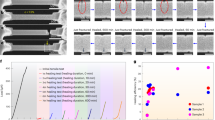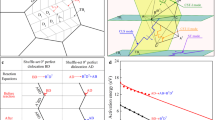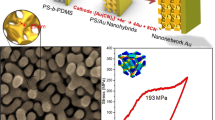Abstract
The well known trade-off between hardness and toughness (resistance to fracture) makes simultaneous improvement of both properties challenging, especially in diamond. The hardness of diamond can be increased through nanostructuring strategies1,2, among which the formation of high-density nanoscale twins — crystalline regions related by symmetry — also toughens diamond2. In materials other than diamond, there are several other promising approaches to enhancing toughness in addition to nanotwinning3, such as bio-inspired laminated composite toughening4,5,6,7, transformation toughening8 and dual-phase toughening9, but there has been little research into such approaches in diamond. Here we report the structural characterization of a diamond composite hierarchically assembled with coherently interfaced diamond polytypes (different stacking sequences), interwoven nanotwins and interlocked nanograins. The architecture of the composite enhances toughness more than nanotwinning alone, without sacrificing hardness. Single-edge notched beam tests yield a toughness up to five times that of synthetic diamond10, even greater than that of magnesium alloys. When fracture occurs, a crack propagates through diamond nanotwins of the 3C (cubic) polytype along {111} planes, via a zigzag path. As the crack encounters regions of non-3C polytypes, its propagation is diffused into sinuous fractures, with local transformation into 3C diamond near the fracture surfaces. Both processes dissipate strain energy, thereby enhancing toughness. This work could prove useful in making superhard materials and engineering ceramics. By using structural architecture with synergetic effects of hardening and toughening, the trade-off between hardness and toughness may eventually be surmounted.
This is a preview of subscription content, access via your institution
Access options
Access Nature and 54 other Nature Portfolio journals
Get Nature+, our best-value online-access subscription
$29.99 / 30 days
cancel any time
Subscribe to this journal
Receive 51 print issues and online access
$199.00 per year
only $3.90 per issue
Buy this article
- Purchase on Springer Link
- Instant access to full article PDF
Prices may be subject to local taxes which are calculated during checkout




Similar content being viewed by others
Data availability
The data that support the findings of this study are available from the corresponding authors on reasonable request.
References
Irifune, T., Kurio, A., Sakamoto, S., Inoue, T. & Sumiya, H. Ultrahard polycrystalline diamond from graphite. Nature 421, 599–600 (2003).
Huang, Q. et al. Nanotwinned diamond with unprecedented hardness and stability. Nature 510, 250–253 (2014).
Shin, Y. A. et al. Nanotwin-governed toughening mechanism in hierarchically structured biological materials. Nat. Commun. 7, 10772 (2016).
Munch, E. et al. Tough, bio-inspired hybrid materials. Science 322, 1516–1520 (2008).
Bouville, F. et al. Strong, tough and stiff bioinspired ceramics from brittle constituents. Nat. Mater. 13, 508–514 (2014).
Mao, L.-B. et al. Synthetic nacre by predesigned matrix-directed mineralization. Science 354, 107–110 (2016).
Zhang, Y. et al. Graphene-based artificial nacre nanocomposites. Chem. Soc. Rev. 45, 2378–2395 (2016).
Hannink, R. H. J., Kelly, P. M. & Muddle, B. C. Transformation toughening in zirconia-containing ceramics. J. Am. Ceram. Soc. 83, 461–487 (2000).
Li, F. et al. Dual-phase super-strong and elastic ceramic. ACS Nano 13, 4191–4198 (2019).
Drory, M. D., Dauskardt, R. H., Kant, A. & Ritchie, R. O. Fracture of synthetic diamond. J. Appl. Phys. 78, 3083–3088 (1995).
Ashby, M. F. Materials Selection in Mechanical Design 5th edn (Elsevier, 2017).
Lu, L., Chen, X., Huang, X. & Lu, K. Revealing the maximum strength in nanotwinned copper. Science 323, 607–610 (2009).
Yue, Y., Zhang, Q., Yang, Z., Gong, Q. & Guo, L. Study of the mechanical behavior of radially grown fivefold twinned nanowires on the atomic scale. Small 12, 3503–3509 (2016).
Lu, K. Stabilizing nanostructures in metals using grain and twin boundary architectures. Nat. Rev. Mater. 1, 16019 (2016).
Wen, B., Zhao, J., Bucknum, M. J., Yao, P. & Li, T. First-principles studies of diamond polytypes. Diam. Relat. Mater. 17, 356–364 (2008).
Sennour, M., Lartigue-Korinek, S., Champion, Y. & Hÿtch, M. J. HRTEM study of defects in twin boundaries of ultra-fine grained copper. Phil. Mag. 87, 1465–1486 (2007).
Wang, Y. B., Wu, B. & Sui, M. L. Dynamical dislocation emission processes from twin boundaries. Appl. Phys. Lett. 93, 041906 (2008).
Németh, P. et al. Lonsdaleite is faulted and twinned cubic diamond and does not exist as a discrete material. Nat. Commun. 5, 5447 (2014).
Greshnyakov, V. A., Belenkov, E. A. & Brzhezinskaya, M. M. Theoretical investigation of phase transitions of graphite and cubic 3C diamond into hexagonal 2H diamond under high pressures. Phys. Status Solidi B 256, 1800575 (2019).
Kubo, T. et al. An in situ X ray diffraction study of the α–β transformation kinetics of Mg2SiO4. Geophys. Res. Lett. 25, 695–698 (1998).
Ji, C. et al. Shear-induced phase transition of nanocrystalline hexagonal boron nitride to wurtzitic structure at room temperature and lower pressure. Proc. Natl Acad. Sci. USA 109, 19108–19112 (2012).
E1820. Standard Test Method for Measurement of Fracture Toughness (American Society for Testing and Materials, 2006).
Tian, Y. et al. Ultrahard nanotwinned cubic boron nitride. Nature 493, 385–388 (2013).
Tatarko, P. et al. Toughening effect of multi-walled boron nitride nanotubes and their influence on the sintering behaviour of 3Y-TZP zirconia ceramics. J. Eur. Ceram. Soc. 34, 1829–1843 (2014).
Xu, F. M., Zhang, Z. J., Shi, X. L., Tan, Y. & Yang, J. M. Effects of adding yttrium nitrate on the mechanical properties of hot-pressed AlN ceramics. J. Alloys Compd. 509, 8688–8691 (2011).
Liu, C. et al. Texture, microstructures, and mechanical properties of AlN-based ceramics with Si3N4–Y2O3 additives. J. Am. Ceram. Soc. 100, 3380–3384 (2017).
Ritchie, R. O. The conflicts between strength and toughness. Nat. Mater. 10, 817–822 (2011).
Gale, W. F. & Totemeier, T. C. Smithells Metals Reference Book 8th edn (Elsevier Butterworth-Heinemann, 2004).
Zhang, Y. et al. Direct observation of super-plasticity of beta-SiC nanowires at low temperature. Adv. Funct. Mater. 17, 3435–3440 (2007).
Ownby, P. D., Yang, X. & Liu, J. Calculated X-ray diffraction data for diamond polytypes. J. Am. Ceram. Soc. 75, 1876–1883 (1992).
Xue, X. Y., Zhang, R. Q. & Zhang, X. H. Structural and electronic properties of 9R diamond polytype. Solid State Commun. 136, 41–44 (2005).
Koester, K. J., Ager, J. W. III & Ritchie, R. O. The true toughness of human cortical bone measured with realistically short cracks. Nat. Mater. 7, 672–677 (2008).
Roundy, D. & Cohen, M. L. Ideal strength of diamond, Si, and Ge. Phys. Rev. B 64, 212103 (2001).
Pan, Z., Sun, H., Zhang, Y. & Chen, C. Harder than diamond: superior indentation strength of wurtzite BN and lonsdaleite. Phys. Rev. Lett. 102, 055503 (2009).
Kresse, G. & Furthmüller, J. Efficient iterative schemes for ab initio total-energy calculations using a plane-wave basis set. Phys. Rev. B 54, 11169–11186 (1996).
Ceperley, D. M. & Alder, B. J. Ground state of the electron gas by a stochastic method. Phys. Rev. Lett. 45, 566–569 (1980).
Perdew, J. P. & Zunger, A. Self-interaction correction to density-functional approximations for many-electron systems. Phys. Rev. B 23, 5048–5079 (1981).
Acknowledgements
This work was supported by the National Key R&D Program of China (2018YFA0703400 and 2018YFA0305900), the National Natural Science Foundation of China (51922017, 51525205, 51772011, 51672239, 51572235, 51741201, 51772260, 51972009, 51532001, 11674176 and 11874224), US National Science Foundation (EAR-1661489 and EAR-1361276) and the Fundamental Research Funds for Central Universities (YWF-19-BJ-J-94). We thank M. Veron at Grenoble Institute of Technology for the precession electron diffraction measurement.
Author information
Authors and Affiliations
Contributions
Y.T., Y.Y., B.X., X.-F.Z. and L.G. proposed and supervised the project; Y.G., Z.L., P.Y., X.L. and D.Y. synthesized the sample; Y.Y., W.H., B.X., B.G., Z.W., B.W. and X.-F.Z. performed the TEM characterization; Y.Y., J.W., X.Z. and Q.Z. performed the in situ bending experiments; Y.G., P.Y. and B.X. performed the Vickers indentation measurements; X.-F.Z. performed the first-principles calculations; Z.Y. performed the finite element simulations; Y.Y., Y.T., B.X., Y.W., X.-F.Z. and L.G. analysed data and wrote the manuscript. All authors participated in discussions of the research.
Corresponding authors
Ethics declarations
Competing interests
The authors declare no competing interests.
Additional information
Publisher’s note Springer Nature remains neutral with regard to jurisdictional claims in published maps and institutional affiliations.
Extended data figures and tables
Extended Data Fig. 1 Microstructure and X-ray diffraction patterns of nt-diamond composite synthesized at 15 GPa and 2,000 °C.
a, Low-magnification bright-field STEM image showing interlocked grains composed of nanotwins. Coloured lines indicate five different TB orientations. b, HRTEM image from the red-boxed region in a, showing interwoven nanotwins with embedded secondary phases. Inset shows the corresponding FFT pattern. In addition to the fivefold patterns from the multi-directional 3C diamond twins in the interlocked grains, extra diffraction spots from coherent non-3C diamond polytypes are clearly recognized. c, X-ray diffraction characterization. A shoulder is clearly observed at the lower-angle side of 3C diamond (111) peak near 44° (left panel of c), an indicator of polytype existence.
Extended Data Fig. 2 Hierarchical microstructure of nt-diamond composite.
a, Bright-field STEM image showing three interlocked nanograins with boundaries appearing diffuse or segmented by intersecting twin boundaries. The Moiré fringes (enclosed with yellow-dashed lines) indicate three-dimensional interpenetrating grain boundaries, which lock neighbouring grains and cause grain overlapping near the boundaries. b, c, HAADF-STEM images corresponding to the red and blue boxes in a, respectively, displaying segmented boundaries with {111} TBs (red lines) and other boundaries (cyan lines). SFs (single arrowheads) and ESFs (double arrowheads) are also marked. A 9R polytype region is also clearly recognizable in b. d, HAADF-STEM image of 3C nanotwins with coherently embedded 2H and 4H polytypes. Inset, FFT pattern corresponding to the red-boxed area, showing the symmetry of 2H and 4H polytypes. TBs and SFs are marked with red lines and arrowheads, respectively. Layer defects are marked with green ovals. Along the long axes of the ovals, the TB and stacking fault climb by one bilayer. e, HAADF-STEM image of a 9R polytype region coherently embedded in 3C diamond. The cyan dashed line indicates the grain boundary. Inset, FFT pattern corresponding to the red-boxed area, showing a tripling of (111)3C periodicity. f, Stacking sequences of 3C, 2H, 4H, 9R and 15R polytypes. g, Simulated electron diffraction pattern of 2H polytype (right) compared with experimental FFT pattern (left; inset of Fig. 2b). h, Simulated electron diffraction patterns of 9R (left) and 15R (right) polytypes compared with experimental FFT pattern (middle; inset of Fig. 2c).
Extended Data Fig. 3 Details of a localized layer defect in nt-diamond composite.
a, A high-resolution HAADF-STEM image shows a localized layer defect between 3C and 2H domains (green-dashed frame). The carbon bilayers and the TB (red line) are obviously bent because of the bulge produced by the defect. b, Electron energy-loss spectra from the defective region (green) and 3C diamond region (red). Note that the region with the layer defect exhibits a peak near 286 eV (black arrow), suggesting sp2 bonds in the layer defect and consistent with the enlarged interlayer distance. The 3C region, on the other hand, exhibits peaks typical of diamond.
Extended Data Fig. 4 Crystallographic characterization of nt-diamond composite with precession electron diffraction.
a, Virtual bright-field image. b, Crystallographic orientation map corresponding to a. Inset, the chromatic code of the cubic inverse pole figure. c, Grain and twin boundaries, among which the Σ3 boundaries are coloured in red. d, Remaining grain boundaries after removing Σ3 and Σ9 low-energy boundaries, indicating a substantial grain interlocking. The average grain size in nt-diamond composite is 22 nm as determined by precession electron diffraction.
Extended Data Fig. 5 SENB sample preparation and time-sequential SENB bending tests.
Sample preparation was with FEI (Helios Nanolab 600i). Time-sequential SENB bending tests were carried out on sample 3 after the first test shown in Fig. 3. a, SEM image of the sample after excavating craters, with a thin wall in between. b, A thin wall taken out to prepare TEM foil. c, A micro-beam shaped from the thin wall described in a. Note the precut notch on the underside of the micro-beam. d−f, SEM images from the second-round multi-cycle bending test. g−i, SEM images from the third-round test. j, k, Force−displacement curves of the first- and second-round SENB tests. Blue arrows indicate yielding points.
Extended Data Fig. 6 Comparison of fracture toughness values from SENB and indentation measurements for Y-PSZ, pure nt-diamond and nt-diamond composite.
SENB, filled bars; indentation, empty bars. The loads for indentation fracture toughness measurement were 49 N for Y-PSZ, and 19.6 N for pure nt-diamond and nt-diamond composite. Error bars indicate 1 s.d. (n = 5 for Y-PSZ and nt-diamond composite, n = 3 and 5 for indentation and SENB measurements of pure nt-diamond, respectively). ntD, nt-diamond.
Extended Data Fig. 7 An nt-diamond composite before and after in situ fracture test in TEM.
a–d, SEM observation of the test piece. a, Before the fracture test. b, After the fracture test. c, d, Enlarged SEM images corresponding to the yellow and red boxes in b, respectively. Arrows in c highlight the sinuous crack propagation path in non-3C polytypes. Double-headed arrow in d indicates a pull-out fracture in nt-diamond composite. Such pull-out fractures are common in composite materials with enhanced toughness. e, f, Plastic deformation near the crack tip from in situ TEM observation. e, HRTEM image of nt-diamond composite taken near the crack tip (corresponding to the small yellow box in the inset) where stacking faults (green arrows) can be identified. f, Inverse FFT image corresponding to red box in e. An extended dislocation with a Burger’s vector of 1/2 <110> is clearly shown by the Burger’s circuit (yellow).
Extended Data Fig. 8 Structural transformation from 9R diamond to 3C diamond.
a, Projection view of 9R and 3C diamonds with redefined unit cells. The yellow and green dashed lines represent the glide and shuffle planes, respectively. b, Stress–strain curves of 9R diamond sheared along (001)[11\(\bar{2}\)] and (001)[\(\bar{1}\bar{1}\)2] directions, corresponding to the red and blue arrows in a, respectively. The peaks of shear stress in these two directions are 103 GPa and 101 GPa, indicating no distinct easy or hard directions. c, Energy–strain curves of 9R diamond along (001)[11\(\bar{2}\)] and (001)[\(\bar{1}\bar{1}\)2] directions. d, Structural snapshots from I to II (sheared along (001)[11\(\bar{2}\)] and from III to IV (sheared along (001)[\(\bar{1}\bar{1}\)2]). Points I−IV are marked in b. The calculated energy–strain curves indicate that 9R to 3C transformation with a smaller energy barrier is preferred, rather than the collapsed layer structure. Under shear along (001)[\(11\bar{2}\)], C−C bonds across shuffle planes are tilted towards (001)[\(11\bar{2}\)], with one-ninth of bonds across glide planes broken beyond critical strain (two bonds per unit cell, marked with red cross in d). In comparison, all bonds across shuffle planes (six bonds per unit cell, marked with blue crosses in d) are broken under shear along (001)[\(\bar{1}\bar{1}\)2].
Extended Data Fig. 9 Finite element simulation results of SENB tests.
a, von Mises stress distribution in the bending test with increasing load. b, Axial strain distribution in the cantilever corresponding to a. c, The stress distribution in conventional SENB test with hinged ends. d, The stress distribution in our SENB test with fixed ends.
Supplementary information
Video 1
First-round multi-cycle bending test on Sample 3 and the corresponding force−displacement curve (shown in Figs. 3a−3d and Extended data Fig. 5j); video speed at 10 times the speed of experiment.
Video 2
Second-round multi-cycle bending test on Sample 3 and the corresponding force−displacement curve (shown in Extended data Figs. 5d−5f and 5k); video speed at 10 times the speed of experiment.
Video 3
Third-round multi-cycle bending test on Sample 3 (shown in Extended data Figs. 5g−5i); video speed at 5 times the speed of experiment. The small bulb squeezed out in the end of the second-round of bending test was torn into halves. This suggests the crack propagated through the bulb that binds the left and right sides together, a direct evidence of self-healing.
Rights and permissions
About this article
Cite this article
Yue, Y., Gao, Y., Hu, W. et al. Hierarchically structured diamond composite with exceptional toughness. Nature 582, 370–374 (2020). https://doi.org/10.1038/s41586-020-2361-2
Received:
Accepted:
Published:
Issue Date:
DOI: https://doi.org/10.1038/s41586-020-2361-2
This article is cited by
-
Structural transition and migration of incoherent twin boundary in diamond
Nature (2024)
-
Toughening oxide glasses through paracrystallization
Nature Materials (2023)
-
Self-healing of fractured diamond
Nature Materials (2023)
-
Enhancement of short/medium-range order and thermal conductivity in ultrahard sp3 amorphous carbon by C70 precursor
Nature Communications (2023)
-
Fractured diamond can heal itself at room temperature
Nature Materials (2023)
Comments
By submitting a comment you agree to abide by our Terms and Community Guidelines. If you find something abusive or that does not comply with our terms or guidelines please flag it as inappropriate.



